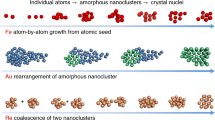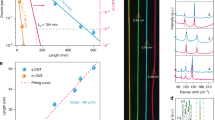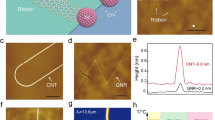Abstract
The synthesis of carbon nanotubes (CNTs) of desired chiralities and diameters is one of the most important challenges in nanotube science and achieving such selectivity may require a detailed understanding of their growth mechanism. We report the formation of CNTs in an entirely condensed phase process that allows us, for the first time, to monitor the nucleation of a nanotube on the spherical surface of a metal particle. When multiwalled CNTs containing metal particle cores are irradiated with an electron beam, carbon from graphitic shells surrounding the metal particles is ingested into the body of the particle and subsequently emerges as single-walled nanotubes (SWNTs) or multiwalled nanotubes (MWNTs) inside the host nanotubes. These observations, at atomic resolution in an electron microscope, show that there is direct bonding between the tubes and the metal surface from which the tubes sprout and can be readily explained by bulk diffusion of carbon through the body of catalytic particles, with no evidence of surface diffusion.
This is a preview of subscription content, access via your institution
Access options
Subscribe to this journal
Receive 12 print issues and online access
$259.00 per year
only $21.58 per issue
Buy this article
- Purchase on Springer Link
- Instant access to full article PDF
Prices may be subject to local taxes which are calculated during checkout





Similar content being viewed by others
References
Dai, H. Nanotube growth and characterization in Carbon Nanotubes: Synthesis, Structure and Applications (eds Dresselhaus, M. S., Dresselhaus, G. & Avouris, P. ) 29–53 (Springer, Berlin/Heidelberg, 2001).
Helveg, S. et al. Atomic-scale imaging of carbon nanofiber growth. Nature 427, 426–429 (2004).
Lin, M. et al. Direct observation of single-walled carbon nanotube growth at the atomic scale. Nano Lett. 6, 449–452 (2006).
Sharma, R. & Iqbal, Z. In situ observations of carbon nanotube formation using environmental transmission electron microscopy. Appl. Phys. Lett. 84, 990–992 (2004).
Baker, R. T. K., Harris, P. S., Thomas, R. B. & Waite, R. J. Formation of filamentous carbon from iron, cobalt and chromium catalyzed decomposition of acetylene. J. Catal. 30, 86–95 (1973).
Raty, J. Y., Gygi, F. & Galli, G. Growth of carbon nanotubes on metal nanoparticles: a microscopic mechanism from ab-initio molecular dynamics simulations. Phys. Rev. Lett. 95, 096103 (2005).
Gavillet, J. et al. Root-growth mechanism for single-wall carbon nanotubes. Phys. Rev. Lett. 87, 275504 (2001).
Hofmann, S., Csanyi, G., Ferrari, A. C., Payne, M. C. & Robertson, J. Surface diffusion: the low activation energy path for nanotube growth. Phys. Rev. Lett. 95, 036101 (2005).
Schaper, A. K., Hou, H. Q., Greiner, A. & Phillipp, F. The role of iron carbide in multiwalled carbon nanotube growth. J. Catal. 222, 250–254 (2004).
Banhart, F., Li, J. X. & Krasheninnikov, A. V. Carbon nanotubes under electron irradiation: stability of the tubes and their action as pipes for atom transport. Phys. Rev. B 71, 241408 (2005).
Sun, L. et al. Carbon nanotubes as high pressure cylinders and nanoextruders. Science 312, 1199–1202 (2006).
Kamalakaran, R. et al. Synthesis of thick and crystalline nanotube arrays by spray pyrolysis. Appl. Phys. Lett. 77, 3385–3387 (2000).
Mayne, M. et al. Pyrolytic production of aligned carbon nanotubes from homogeneously dispersed benzene-based aerosols. Chem. Phys. Lett. 338, 101–107 (2001).
Elías, A. L. et al. Production and characterization of single-crystal FeCo nanowires inside carbon nanotubes. Nano Lett. 5, 467–472 (2005).
Banhart, F., Redlich, Ph. & Ajayan, P. M. The migration of metal atoms through carbon onions. Chem. Phys. Lett. 292, 554–560 (1998).
Banhart, F. Irradiation effects in carbon nanostructures. Rep. Prog. Phys. 62, 1181–1221 (1999).
McLellan, R. B., Ko, C. & Wasz, M. L. The diffusion of carbon in solid cobalt. J. Phys. Chem. Solids 53, 1269–1273 (1992).
Abild-Pedersen, F., Nørskov, J. K., Rostrup-Nielsen, J. R., Sehested, J. & Helveg, S. Mechanisms for catalytic carbon nanofiber growth studied by ab-initio density functional theory calculations. Phys. Rev. B 73, 115419 (2006).
Xu, C. H., Fu, C. L. & Pedraza, D. F. Simulations of point defect properties in graphite by a tight-binding force model. Phys. Rev. B 48, 13273–13279 (1993).
Sun, L. & Banhart, F. Graphitic onions as reaction cells on the nanoscale. Appl. Phys. Lett. 88, 193121 (2006).
Amara, H., Bichara, C. & Ducastelle, F. Formation of carbon nanostructures on nickel surfaces: a tight-binding grand canonical Monte Carlo study. Phys. Rev. B 73, 113404 (2006).
Acknowledgements
Support from the Deutsche Forschungsgemeinschaft (BA 1884/4-1) and the International Max Planck Research School in Mainz (J.A.R.-M.) is gratefully acknowledged. We also thank CONACYT-Mexico for scholarship (J.A.R.-M.) and grants 45772 (M.T.), 45762 (H.T.), 42428-Inter American Collaboration (H.T.), 41464-Inter American Collaboration (M.T.), 2004-01-013-SALUD-CONACYT (M.T.) and PUE-2004-CO2-9 Fondo Mixto de Puebla (M.T.). We thank A. Elías and A. Zamudio for assistance in the preparation of the FeCo sample and A. Krasheninnikov for fruitful discussions. H.W.K. thanks The Florida State University for financial support.
Author information
Authors and Affiliations
Corresponding author
Ethics declarations
Competing interests
The authors declare no competing financial interests.
Supplementary information
Supplementary Information
Supplementary text, movie legends and supplementary figure 1 (PDF 1405 kb)
Supplementary Information
Supplementary movie 1 (AVI 1116 kb)
Supplementary Information
Supplementary movie 2 (AVI 2443 kb)
Rights and permissions
About this article
Cite this article
Rodríguez-Manzo, J., Terrones, M., Terrones, H. et al. In situ nucleation of carbon nanotubes by the injection of carbon atoms into metal particles. Nature Nanotech 2, 307–311 (2007). https://doi.org/10.1038/nnano.2007.107
Received:
Accepted:
Published:
Issue Date:
DOI: https://doi.org/10.1038/nnano.2007.107
This article is cited by
-
Continuously processing waste lignin into high-value carbon nanotube fibers
Nature Communications (2022)
-
Electron beam-induced changes in tips of multi-walled carbon nanotubes with/without Au nanoparticles
Applied Nanoscience (2020)
-
Comparison of atomic scale dynamics for the middle and late transition metal nanocatalysts
Nature Communications (2018)
-
Considerable knock-on displacement of metal atoms under a low energy electron beam
Scientific Reports (2017)
-
Can We Optimize Arc Discharge and Laser Ablation for Well-Controlled Carbon Nanotube Synthesis?
Nanoscale Research Letters (2016)



